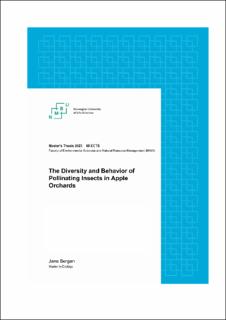| dc.description.abstract | Diverse assemblages of insects improve the overall productivity and stability of natural and agricultural ecosystems. Cultivated fruit crops, such as apples, that require pollination services by insects are particularly sensitive to changes in insect species richness and abundance. I explored the differences in insect diversity within apple orchards and surrounding wild habitat. Three times as many insects were trapped in wild areas adjacent to the orchards as inside of them, suggesting that even small areas of wild habitat within human dominated landscapes can support a relatively high level of insect diversity. This was also the case for pollinating insects, with 22 bee species were trapped outside the orchards and 17 inside. Honeybees were the only bees more commonly found inside the orchards, as bumblebees were more abundant in more natural habitats and solitary bees showed no difference. Further, I quantified the differences in pollinator behavior within apple orchards to estimate pollinator effectiveness. Bumblebees visited significantly more flowers than honeybees over the observation period of three minutes. The foraging behavior of honeybees and bumblebees differed, with honeybees spending significantly more time on the side of the flower not touching the pollen, but also more time actively gathering pollen. Bumblebees spent more time flying, as they generally flew longer distances. Nearly all bumblebees (96%) visited more than one tree during the observation period, while only about half of honeybees did (56%). Bumblebees were more than three times more likely to visit more than one row within the orchard during the observation than honeybees; a behavior that increases the likelihood of successful crosspollination between cultavrs. Crosspollination between cultivars is essential for apple fruit set, which suggests that bumblebee behavior is more likely to increase overall apple yield. An increase in the amount of wild habitat around the orchards is encouraged to support wild bee populations. | |
